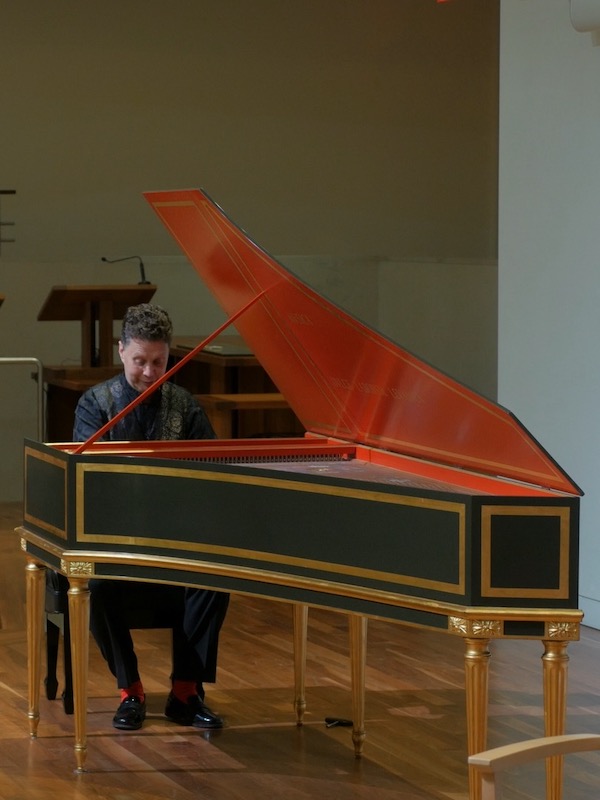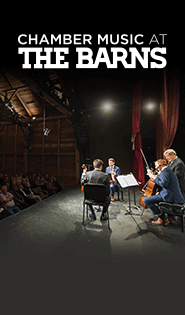Capriccio Baroque series reopens with versatile Vinikour at the harpsichord

Jory Vinokour performed Saturday night in Capriccio Baroque’s reopening. Photo: Patrick Merrill
After a year and a half of coronavirus restrictions, classical music is returning to live performances. The latest presenter to be revived is Capriccio Baroque, a series of intimate concerts directed by Carolyn Winter and mostly centered on the harpsichord.
On Saturday evening harpsichordist Jory Vinikour gave a recital to an audience of about fifty listeners in the sanctuary of First Congregational UCC, otherwise known as Live at 10th and G.
It was a bittersweet moment, as Washingtonians may be able to hear the Chicago-based Vinikour less often going forward. During a brief post-performance chat with radio announcer Robert Aubry Davis, Vinikour announced that he would be resettling permanently in France, where he has also lived much of his life, at the end of 2021.
This program captured the sense of life’s joys returning after the pandemic lockdowns, featuring effervescent and devilishly challenging pieces. It opened with William Byrd’s The Bells, an evocation of the tintinnabulation from London’s churches. Built on a two-note bass pattern (C-D), the piece trades ever more complex motifs between left and right hands. Vinikour ably captured this array of cascading peals, concluding with dizzying runs of sixteenth notes.
John Bull’s The King’s Hunt required a similar amount of finger-twisting calisthenics. Vinikour cut through the thicket of repeated notes, spritely runs, and oscillating figures, creating a cloud of sounds like the cacophony of a pack of dogs, horn calls, and animal cries. With these displays of showmanship, Vinikour showed off the responsive action of this double-manual harpsichord built by William Dowd in 1972.
The instrument’s more sensitive and varied side came out in a blockbuster rendition of Bach’s Toccata in D Major. Vinikour skillfully manipulated the various registrations available to create a multitude of contrasting characters, matching the freeform fantasy of Bach’s composition, shifting like quicksilver between manic episodes and more reflective interludes. The concluding jig fugue made a frolicking conclusion.
A side note on the harpsichord, now owned by Winter and featured in Capriccio’s concerts. Dowd built it for John Lewis, the leader of the Modern Jazz Quartet, according to Barbara Wolf, the early keyboard maker on hand to tune the instrument. Because Lewis was left-handed, Dowd placed a stop generally found on the right side of the instrument, where it could be easily reached by a right-handed player, on the left.
Having gone through Elizabethan England and Baroque Germany, Vinikour finished off his first half with two brilliant sonatas by Domenico Scarlatti, born in Italy and resident in Spain. The Sonata in B Minor, K. 87, was steeped in introspection, with the first section repeated on a softer registration and hesitations of articulation bringing out a poignant half-step motif heard multiple times.
Vinikour took the contrasting Sonata in D Major, K. 535, at a brilliant fast tempo, concluding the first half with more virtuosic display. He brought out Scarlatti’s motif of rapidly ascending scales, traded back and forth between octaves and manuals, with an ingenious use of registration sleights of hand, rendering each successive scale softer and softer as they rocketed upward.
The French selections on the second half opened with Louis Couperin’s Passacaille in C Major, from the Bauyn Manuscript. Vinikour’s ornamentation was rich in tightly coordinated trills, and he enjoyed the unusual harmonic twists in the piece. The diminished-octave clashes in the sixth couplet (B-natural against B-flat) were particularly spicy.
Five character pieces by Rameau recalled the delights of Vinikour’s acclaimed recording of this composer’s music. Delicate registrations heightened the enigmatic qualities of “L’Entretien des Muses.” Since there is no variety in the way a note is struck on the harpsichord, the interest comes in the use of rubato, expressive distortions of tempo, which Vinikour finessed remarkably in this sensitive rendition.
Each Rameau piece presented a stylish vignette, from the steady clicking and whirling of “Les Tourbillons,” to the clucking jokes of “Le Lardon” and the loping steps of “La Boiteuse.” In the final piece, “Les Cyclopes,” Vinikour emphasized the clomping bass notes, making the many large leaps required of the left hand with little adjustment to the tempo.
A final set of three pieces by Pancrace Royer added a sense of the theatrical, with lofty solemnity in “Allemande (La Marche avant le Sacrifice)” and harmonic wandering in the gentle “La Sensible.” Vinikour’s buzzing trills and crackling fingerwork amped up the barbaric nature of the final showpiece, the dazzling “Marche des Scythes.” A single encore, François Couperin’s enigmatic “Les Barricades Mystérieuses,” capped a sensational evening.
Capriccio Baroque’s season of mostly harpsichord recitals will be attended by small audiences who must present proof of coronavirus vaccination and wear masks. capricciobaroque.org


